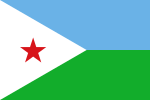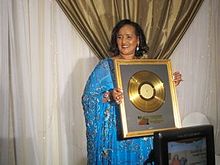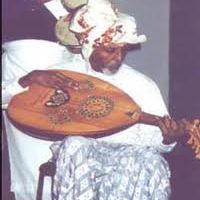Music of Somalia
 |
| Part of a series on the |
| Culture of Somalia |
|---|
| Culture |
| People |
| Religion |
| Language |
| Politics |
The Music of the Somali people (
Overview
Traditional Somali music

Somali people have a rich musical heritage centered on traditional Somali folklore.
 |
| Part of a series on the |
| Culture of Djibouti |
|---|
| Culture |
|
People |
|
Religion |
| Language |
| Politics |
|
|
Somali songs are
Traditional instruments prominently featured in the music of
- Membranophones: nasaro, mokhoddon and masoondhe (high and heavy drums), reeme, jabbu and yoome (small drums);
- Aerophones: malkad and siinbaar (flutes), sumaari (double clarinet), fuugwo (trumpet) buun, muufe and gees-goodir (horns);
- Idiophones: shagal (metal clappers), shanbaal (wooden clappers), shunuuf (vegetable ankle rattles), tenegyo (xylophone);
- Chordophones: shareero (thumb piano), seese (one-chord violin)
History


Somali popular music began with the balwo style, pioneered by Abdi Sinimo, who rose to fame in the early 1940s.[6][7] This new genre then in turn created the Heelo style of Somali music.[8] Abdi's innovation and passion for music revolutionized Somali music forever.[9]
Introduction of melody in modern Somali song is credited to Abdullahi Qarshe, who is recognised for introducing the kaban (oud) as an accompaniment to Somali music.[10] Qarshe is revered by Somalis as "father of Somali music".[11]
Many qaraami songs from this era are still extremely popular today. This musical style is mostly played on the kaban (oud). Prominent Somali kaban players of the 1950s include Ali Feiruz and Mohamed Nahari.
During the rule of the Supreme Revolutionary Council (Somalia), music was suppressed except for a small amount of officially sanctioned music. There were many protest songs produced during this period, pioneered by the people of Somaliland who were trying to gain independence from the government of Somalia, especially the genocidal Barre regime.
Bands such as Waaberi and Horseed have gained a small following outside of the country. Others, like Ahmed Ali Egal, Maryam Mursal and Waayaha Cusub have fused traditional Somali music with pop, rock and roll, bossa nova, jazz, and other modern influences.
Music recorded in the 1970s was preserved in Hargeisa, buried underground, and is now available at the Red Sea Foundation at the Hargeisa Cultural Center, and in Radio Hargeisa. The Barre dictatorial regime effectively nationalised the music scene, with bands and production under state control. Bands were operated by the police, the army and the national penitentiary. Female singers were encouraged more than was the case in most of East Africa. Most musicians had left the country before 1991. Hiddo Dhawr is now operating as the only live music venue in the city.[12]
Music institutions
The first
List of Somali musicians and musical groups

- Aar Maanta
- Abdi Sinimo
- Abdullahi Qarshe
- Ahmed Gacayte
- Ahmed Mooge Liban
- Ali Feiruz
- Nimco Omer
- Yasminah
- Dur-Dur Band
- Doni B
- Guduuda 'Arwo
- Gulled Simba
- Hasan Adan Samatar
- Hassan Sheikh Mumin
- Jiim Sheikh Muumin
- Khadija Qalanjo
- K'naan
- Mohamed Nuur Giriig
- Saado Ali Warsame
- Sulekha Ali
- Waayaha Cusub
- Mohamed Sulayman Tubeec
- Hudeidi
- Xiddigaha Geeska
See also
Notes
- ^ a b Abdullahi, pp.170-171
- ISBN 978-88-7063-084-8.
- ^ Somali Culture and Folklore (1974) pp.63-64
- ^ Historical Dictionary of Somalia (2003) p. 166
- ^ The Concise Garland Encyclopedia of World Music. p.57-58
- ^ African Language Review, Volume 6. The University of Michigan: F. Cass. 1967. p. 5.
- ISBN 9780521256469.
Cabdi Deeqsi, who created a genre of love poetry called Balwo
- ISBN 1874209812.
- ISBN 9780810866041.
- ^ Brinkhurst, Emma (2012). Music, Memory and Belonging: Oral Tradition and Archival Engagement Among the Somali Community of London's King's Cross. University of London. p. 61.
- ISBN 9788888934471.
- ^ "Uncovering Somalia's forgotten music of the 1970s". Al Jazeera. 18 August 2017. Retrieved 22 August 2017.
- ^ Journal of the Anglo-Somali Society, Issues 30-33. Anglo-Somali Society. 2001. p. 56. Retrieved 28 June 2014.
References
- Abdullahi, Mohamed Diriye (2001). Culture and customs of Somalia. Greenwood. ISBN 978-0-313-31333-2.
- Ministry of Information and National Guidance, Mogadishu, Somalia (1974). Somali Culture and Folklore
- Mukhtar, Mohamed Haji (2003) Historical Dictionary of Somalia. Scarecrow Press. ISBN 0-8108-4344-7
- Puchowski, Douglas (2013). The Concise Garland Encyclopedia of World Music, Volume 1. Routledge, ISBN 9781136095702
